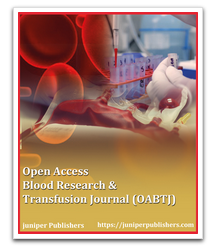Open Access Blood Research & Transfusion Journal - Juniper Publishers
Summary
The Henoch-Schoenlein Purpura was first described in the nineteenth century, but nowadays it is still a challenge in both etiological and clinical aspects. During the period 2014-2018, 44 children at age from 2 months to 17 years were admitted for treatment in the Clinic of Pediatrics, UMHAT” Prof. Dr St. Kirkovich”, Stara Zagora. Our clinical experience gives us the right to assume that the leading etiological role of Streptococci is being competed by other etiological causes, which are potential risk factors for recurrence. According to the therapy, the number of cases with successful treatment without steroids is continuously decreasing.
Introduction
The most common representative of leucocitoclactic vasculitis in children is the Shonlein-Henoch Purpura. Shonlein-Henoch purpura is an IgA mediated vasculitis, which occurs almost exclusively in childhood, with a peak between 5 and 15 years, more often in boys (ratio 1.2-1.8:1)
i. The most common unlocking agent are infections (Group A streptococci, Staphylococci, viruses, etc.).
ii. This group of vasculitis is characterized by leukocytoclasis, which refers t vascular damage, caused by nuclear debris from infiltrating neutrophils [1].
iii. Usually the smallest vessels, such as capillaries, arterioles, venules, small arteries, and veins. The leading clinical presentation is skin syndrome [2].
iv. The skin-joint and abdominal-renal syndromes, described by both authors, outline the full form of the illness [2]. The distinctive sign of the illness is the typical rash.
The clinical presentation consists of:
Skin syndrome- the rash is often the initial sign of the illness. Odemo-hemorrhagic rash (purpura palpable), which varies from urticarial to ulcer-hemorrhagic, symmetrically located on the extensor surface of the limbs, gluteal area and around the joints. It appears at pushes, and all the rash units heal with hypo- or hyperpigmentation of the lesions. Despite the typical lesions, edema of the scrotum and unsymmetrical angioedema of head or limbs are common in children below the age of 2 years [1].
a. Gastro-intestinal involvement is documented in 80% of the children, presented as intermittent abdominal pain, vomiting, diarrhea, usually following the initial distribution of the rash or the joint pain [3]. Hematemesis, melena and bloody diarrhea might be presented as well.
b. Muscle-skeletal involvement is observed in 75% of the children, diagnosed with Henoch-Shonlein purpura [4]. Arthritis/Arthralgia is often an initial distribution of the disease. Although most commonly knees and ankles are affected, rare cases of affected wrists have been documented. Periarticular edema is transient and usually undergoes a total regression in two weeks, but in some instances, it is not uncommon to reoccur.
c. Renal involvement is documented in 50 % of the cases in the form of hematuria, proteinuria, arterial hypertension, nephrotic syndrome, and renal failure [4].
d. CNS vasculitis with the following clinical signs: apathy, irritability, hyperactivity, somnolent, seizures, focal deficits, etc.
Material and Method
During the period 2014-2018 for treatment in the Department of Pediatrics are admitted 44 children (22 boys and 22 girls) at the age from 2 months to 17 years. From them, 22 children were with unfolded clinical manifestation (Skin, joint, and abdominal pain), 13 children with renal involvement. Fifteen children were admitted only with skin involvement, despite the fact that the rash in some of them had the tendency to necrotize (Figure 1). In some of the children, the renal involvement included microscopic hematuria, low proteinuria, without evolution to nephropathy or nephrotic syndrome. Recurrence of the illness is observed in 7 children (15%) [5].
According to the etiological cause in one-third of the children Str. Pneumonia was proved microbiologically, in one patient Candida albicans was found, in three patients -S. Aureus. In five of the children positive serology for EBV and CMV and in one- Q. Burneti IgM (+), IgG (+). In the rest of the cases, no etiological cause was found. In addition, in those children with the proved presence of Str. Pneumoniae AST is >400IU/ml in twelve of them, and in three cases AST is 200IU/ml. In five children with proven different etiology AST s in its referential borders.
Discussion
Despite the fact that the Henoch-Schonlein Purpura was first described in the nineteenth century, nowadays it is a challenge in both etiological and clinical aspects. However, it is a “benign” vasculopathy, the risk of recurrence is increasing. Our clinical experience gives us the right to assume that the leading etiological role of Streptococci is being competed by other etiological causes, which are potential risk factors for recurrence. In many of the cases during the initial disturbance of the illness, the skin rash remains unrecognized, leading to inadequate outpatient therapy, most commonly with antihistamines. According to the therapy, the number of cases with successful treatment without steroids is continuously decreasing. Moreover, our clinical experience proved that steroid therapy is imperative due to the unfolding of the clinical manifestation.
Conclusion
i. The illness of Henoch-Schonlein goes out of the frames of the definition “benign” definitively curable disease.
ii. The clinical cases with only a presentation of skin syndrome are rare and with the tendency of necrotic changes of the lesions.
iii. The treatment without steroids doesn’t lead to definitive control of the clinical symptoms.
iv. Wrongly interpreted skin syndrome in the outpatient care and giving empirical antibiotic treatment makes it difficult and prolongs the time needed for accomplishing health wellbeing of those children.
v. The phenomenon of anticipation is presented in Henoch-Schonlein Purpura.
To Know more about Open Access Blood Research & Transfusion Journal
Click here: https://juniperpublishers.com/index.php





No comments:
Post a Comment